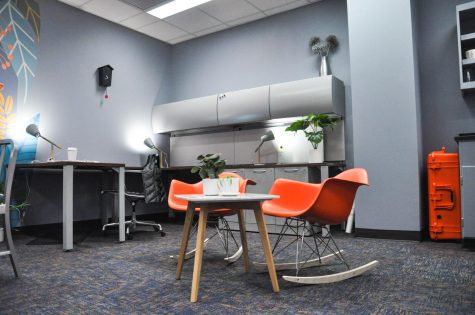(dis)Ability Design Studio welcomes everyone
Deana McDonagh and Adam Bleakney, directors of the (dis)Ability Design Studio, sit in the studio that is located in the Beckman Institute.
October 5, 2022
In November, the Beckman Institute will open the doors to the (dis)Ability Design Studio. The partnership between the Beckman Institute and the University’s Disability Resources and Educational Services will support the interdisciplinary design research focused on real-life experiences of people with disabilities.
Deana McDonagh, professor in FAA and chair of Graphic Design in the college, is proud and passionate about the studio. McDonagh explains that ‘dis’ is in parentheses “to focus on the ability.” McDonagh and Adam Bleakney, a research affiliate in Beckman and DRES, are co-directors of the studio and have been collaborating together since 2017.
In April, McDonagh was named the 2022 Beckman Institute Vision and Spirit Award winner, which is an annual award that recognizes a faculty member who exemplifies the vision of Arnold Beckman — the institute’s founder. The award included $150,000 in research funding, which made the dis(Ability) Design Studio possible.

“This was an opportunity that Adam and I grabbed to create a space on the ground floor, which is easy access,” McDonagh said. “We wanted a welcoming space and it’s really just developing, and we want it to be a catalyst. We don’t know where it’s going, but we have a very strong feeling it’s going to make a change.”
The space is for everyone. Each part of the studio was placed with intention. The chairs are lightweight and easy for anyone to move, and there are only a few because it is encouraged to “bring your own chair.”
Get The Daily Illini in your inbox!
A cuckoo clock hangs on the wall and marks the passing of time with audible cues, which is helpful for people with visual impairments. Instead of a standing whiteboard, there is a table-top version to ensure that there is enough space for wheelchairs and service animals to move throughout the space.
“It was really important that Adam, any of the athletes and any of the students who are wheelchair users could feel like they could go into the kitchen area,” McDonagh said. “I wanted the place to be welcoming and joyful.”
Although the (dis)Ability Design Studio has not officially opened its doors to the public yet, elements of its design have already been integrated into the east wing of Beckman Institute. McDonagh and Amanda Henderson, an alumna of industrial design, worked together to redesign the east wing of Beckman and incorporate empathic design.
McDonagh said she concentrated on improving quality of life with intuitive and innovative products. Bright red rocking chairs, movable hexagonal tables and three “spun chairs” are some of the recent additions.
“You can’t sit in (a spun chair) and not smile!” McDonagh said.
The (dis)Ability Design Studio has a sister site. Bleakney also leads the Human Performance and Mobility Maker Lab within DRES, which develops assistive tools and technology for individuals with disabilities.
“(The (dis)Ability Design Studio and HPML) work synergistically,” Bleakney said. “Whereas we do hands-on development, 3D printing, processing and other types of industrial design, like prototype making.”
The HPML has worked on a variety of projects, such as creating adaptive sports equipment for veterans and 3D printing masks throughout the COVID-19 pandemic.
“We’ve done a project creating wheelchair racing gloves and delivered those to grassroots programs, for children and adults around the country,” Bleakney said. “Currently, (we’re) designing a lightweight and independent aisle chair for use of getting on and off an airplane.”

Joey Peters, a postdoctoral researcher, works with Bleakney and looks at the qualitative data from surveys for assistive device development projects. They also work side-by-side coaching the University’s wheelchair track and field team, which allows them to get user feedback from competitive athletes. The University is an official training site for wheelchair racing in the Paralympic Games.
Another project they are working on is the Personalized Unique Rolling Experience Project, which is a hands-free wheelchair. The project began in 2018 after the team, led by professor Elizabeth Hsiao-Wecksler, placed as semi-finalists at the Toyota Mobility Unlimited Challenge. The project was awarded a $1.5 million grant by the National Science Foundation under the National Robotics Initiative Program.
“(There are) really simple tasks that we take for granted,” Peters said. “Like texting and walking or holding a coffee in your hand, and walking at the same time, or drinking coffee while you’re walking, or holding your wife’s hand while you’re walking. These are very basic activities that we take for granted that a wheelchair user does not have access to because they’re unable to do both at the same time.”
The PURE chair allows wheelchair users to use their hands by moving with the movement of the rest of the body. The chair works like a segway, so the user will use their trunk to tell the chair where to go, opening up many possibilities for people who use wheelchairs that are propelled by the user’s hands.
The (dis)Ability Design Studio is having an invitational event on Nov. 30, and anyone interested in the studio can reach out to McDonagh or Bleakney for more information.
The University is one of the most accessible campuses in the world and with Bleakney and McDonagh working together, Bleakney said he hopes the University will see more changes.
“With the HTML, my goal was to bring every point of campus to DRES,” said Bleakney. “To connect DRES into the north side, east, south, into where we’re at on the west. And now, we’re positioned on the north side. So we can have another point from which we can create interdisciplinary research innovation designing.”







